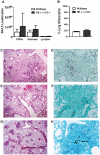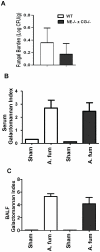Role of NADPH oxidase versus neutrophil proteases in antimicrobial host defense
- PMID: 22163282
- PMCID: PMC3233573
- DOI: 10.1371/journal.pone.0028149
Role of NADPH oxidase versus neutrophil proteases in antimicrobial host defense
Abstract
NADPH oxidase is a crucial enzyme in mediating antimicrobial host defense and in regulating inflammation. Patients with chronic granulomatous disease, an inherited disorder of NADPH oxidase in which phagocytes are defective in generation of reactive oxidant intermediates (ROIs), suffer from life-threatening bacterial and fungal infections. The mechanisms by which NADPH oxidase mediate host defense are unclear. In addition to ROI generation, neutrophil NADPH oxidase activation is linked to the release of sequestered proteases that are posited to be critical effectors of host defense. To definitively determine the contribution of NADPH oxidase versus neutrophil serine proteases, we evaluated susceptibility to fungal and bacterial infection in mice with engineered disruptions of these pathways. NADPH oxidase-deficient mice (p47(phox-/-)) were highly susceptible to pulmonary infection with Aspergillus fumigatus. In contrast, double knockout neutrophil elastase (NE)(-/-)×cathepsin G (CG)(-/-) mice and lysosomal cysteine protease cathepsin C/dipeptidyl peptidase I (DPPI)-deficient mice that are defective in neutrophil serine protease activation demonstrated no impairment in antifungal host defense. In separate studies of systemic Burkholderia cepacia infection, uniform fatality occurred in p47(phox-/-) mice, whereas NE(-/-)×CG(-/-) mice cleared infection. Together, these results show a critical role for NADPH oxidase in antimicrobial host defense against A. fumigatus and B. cepacia, whereas the proteases we evaluated were dispensable. Our results indicate that NADPH oxidase dependent pathways separate from neutrophil serine protease activation are required for host defense against specific pathogens.
Conflict of interest statement
Figures





References
Publication types
MeSH terms
Substances
Grants and funding
LinkOut - more resources
Full Text Sources
Molecular Biology Databases

